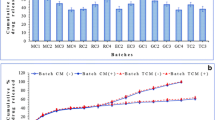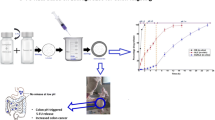Abstract
An objective of the present investigation was to prepare and evaluate Eudragit-coated pectin microspheres for colon targeting of 5-fluorouracil (FU). Pectin microspheres were prepared by emulsion dehydration method using different ratios of FU and pectin (1:3 to 1:6), stirring speeds (500–2000 rpm) and emulsifier concentrations (0.75%–1.5% wt/vol). The yield of preparation and the encapsulation efficiencies were high for all pectin microspheres. Microspheres prepared by using drug:polymer ratio 1:4, stirring speed 1000 rpm, and 1.25% wt/vol concentration of emulsifying agent were selected as an optimized formulation. Eudragit-coating of pectin microspheres was performed by oil-in-oil solvent evaporation method using coat: core ratio (5:1). Pectin microspheres and Eudragit-coated pectin microspheres were evaluated for surface morphology, particle size and size distribution, swellability, percentage drug entrapment, and in vitro drug release in simulated gastrointestinal fluids (SGF). The in vitro drug release study of optimized formulation was also performed in simulated colonic fluid in the presence of 2% rat cecal content. Organ distribution study in albino rats was performed to establish the targeting potential of optimized formulation in the colon. The release profile of FU from Eudragit-coated pectin microspheres was pH dependent. In acidic medium, the release rate was much slower; however, the drug was released quickly at pH 7.4. It is concluded from the present investigation that Eudragit-coated pectin microspheres are promising controlled release carriers for colon-targeted delivery of FU.
Similar content being viewed by others

References
Riley SA, Turnberg LA. Sulphasalazine and aminosalicylate in the treatment of inflammatory bowl disease.Q J Med. 1990;75: 561–562.
Bartalsky A. Salicylazobenzoic acid in ulcerative colitis.Lancet. 1982;319:960–964.
Ashford M, Fell J, Attwood D, Sharma H, Woodhead P. In vitro investigation into the suitability of pH dependent polymer for colonic targeting.Int J Pharm 1993;95:193–199.
Marvola M, Nykanen P, Rautio S, Isonen N, Autere AM. Enteric polymer as binder and coating material in multiple unit site-specific drug delivery systems.Eur J Pharm Sci. 1999;7:259–267.
Gazzaniga A, Busetti C, Sangali ME, Giordana ME. Time-dependent oral delivery system for colonic targeting system for the colon targeting.STP Pharma Sci. 1995;5:83–88.
Gazzaniga A, Iamartino P, Maffione G, Sangal ME. Oral delayed release system system for colonic specific delivery.Int J Pharm. 1994;108:77–83.
Hovgaard L, Brondsted H. Dextran hydrogels for colon-specific drug delivery.J Control Release. 1995;36:159–166.
Watts PJ, Lllum L. Colonic drug delivery.Drug Dev Ind Pharm. 1997;23:893–913.
Ashford M, Fell T. Targeting drugs to colon: delivery system for oral administration.J Drug Target. 1994;2:241–258.
Kudela V. Hydrogels. In: Mark HF, Bikales N, Overberger CG, Menges G, Kroschwitz JI, eds.Encyclopedia of Polymer Science and Engineering. vol. 7. New York, NY: John Wiley & Sons; 1987:703–807.
Graham NB, McNeill ME. Hydrogels for controlled drug delivery.Biomaterials. 1984;5:27–36.
Tiwari SB, Murthy TK, Pai MR, Mehta PR, Chowdary PB. Controlled release formulation of tramadol hydrochloride using hydrophilic and hydrophobic matrix system.AAPS PharmSciTech. 2003;4:E31.
Krusteva S, Lambov N, Velinov G. Pharmaceutical investigation of a bioerodible nystatin system.Pharmazie. 1990;45:195–197.
Naggar VF, El-Khawas M, Ismail FA, Boraie NA. Pectin, a possible matrix for oral sustained release preparations of water-soluble drugs.STP Pharma Sci. 1992;2:227–234.
Rubinstein A, Radai R, Ezra M, Pathak S, Rokem JM. In vitro evaluation of calcium pectinate: a potential colon-specific drug delivery carrier.Pharm Res. 1993;10:258–263.
Esposito E, Cortesi R, Luca G, Nastruzzi C. Pectin based microspheres: a preformulatory study.Ann N Y Acad Sci. 2001;944: 160–179.
Lorenzo-Lamosa ML, Remunan-Lopez C, Vila-Jato JL, Alonso MJ. Design of microen capsulated chitosan microspheres for colonic drug delivery.J Control Release. 1998;52:109–118.
Indian Pharmacopoeia.Disintegration and Dissolution. Delhi, India: Controller of Publication-Ministry of Health and Family Welfare; 1996:
Rai G, Jain SK, Agrawal S, Pancholi SS, Agrawal GP. Chitosan hydrochloride based microspheres of albendazole for colonic drug delivery.Pharmazie. 2005;60:131–134.
Van den Mooter G, Samyn C, Kinget R. The relation between swelling properties and enzymatic degradation of azo polymers designed for colon-specific drug delivery.Pharm Res. 1994;11:1737–1741.
Pongpaibul Y, Price JC, Whitworth CW. Preparation and evaluation of controlled release indomethacin microspheres.Drug Dev Ind Pharm. 1984;410:1597–1616.
Maia JL, Santana MHA, Re MI. The effect of some proceessing conditions on the characteristics of biodegradable microspheres obtained by an emulsion solvent evaporation process.Braz J Chem Eng. 2004;21:1–12.
Yang Q, Owusu-Ababio G. Biodegradable progesterone microsphere delivery system for osteoporosis therapy.Drug Dev Ind Pharm. 2000;26:61–70.
Author information
Authors and Affiliations
Corresponding author
Additional information
Published: February 16, 2007
Rights and permissions
About this article
Cite this article
Paharia, A., Yadav, A.K., Rai, G. et al. Eudragit-coated pectin microspheres of 5-fluorouracil for colon targeting. AAPS PharmSciTech 8, 12 (2007). https://doi.org/10.1208/pt0801012
Received:
Accepted:
DOI: https://doi.org/10.1208/pt0801012



